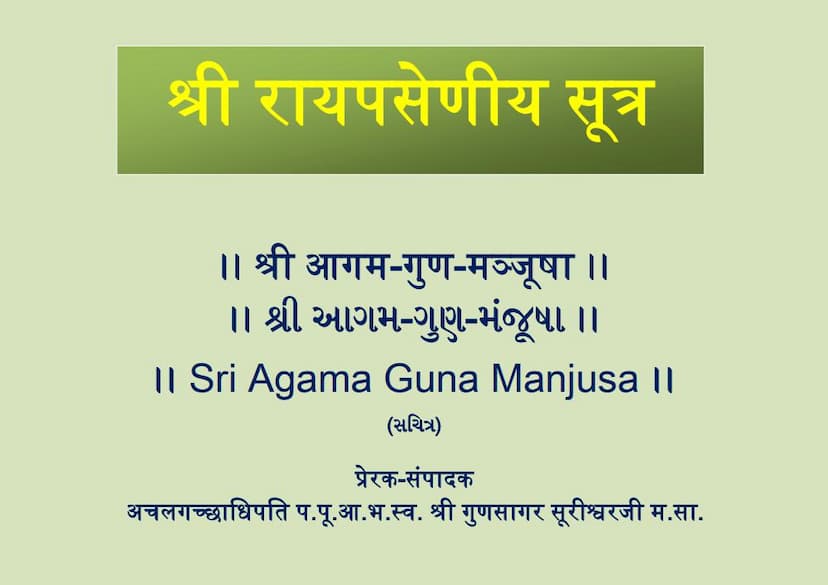Agam 13 Upang 02 Rajprashniya Sutra Shwetambar Agam Guna Manjusha
Added to library: September 1, 2025

Summary
This document, titled "Sri Agama Guna Manjusha," is a compilation containing a brief introduction to the 45 Jain Agamas, followed by specific details and a synopsis of the Rajprashniya Sutra (also known as Rayapaseniya Sutra). The text is presented as part of a larger series aimed at Jain education.
I. Introduction to the 45 Jain Agamas: The initial part of the document provides a structured overview of the 45 Jain Agamas, categorizing them into:
-
Eleven Angas (Main Scriptures): This section lists and briefly describes each of the eleven primary scriptures, including their themes (e.g., conduct, religious discourse, entity, calculation), key contents (e.g., life stories, vows, answers to questions), and approximate number of verses. Notable Angas mentioned are Achārāṅga-sūtra, Sūyagaḍāṅga-sūtra (also Sūtra-Kṛtāṅga-sūtra), Sthānāṅga-sūtra, Samavāyāṅga-sūtra, Vyākhyā-prajñapti-sūtra (also Bhagavatī-sūtra), Jātādhamma-kathāṅga-sūtra, and Upāsaka-daśāṅga-sūtra.
-
Twelve Upangas (Subordinate Scriptures): This section details the twelve Upangas, which are considered auxiliary to the Angas. The Uvavāyi-sūtra, Rāyaprasēṇīya-sūtra, Jivābhigama-sūtra, Prajñāpanā-sūtra, Sūrya-prajñapti-sūtra, Candra-prajñapti-sūtra, Jambūdvīpa-prajñapti-sūtra, and the Nirayāvalī-pācaka group (including Nirayāvalī-sūtra, Kalpāvatansaka-sūtra, Puṣpā-upāṅga-sūtra, Puṣpacūlikā-sūtra, and Vr̥ṣṇidaśa-sūtra) are described.
-
Ten Prakīrṇaka (Miscellaneous) Sutras: This section lists ten sutras considered miscellaneous or scattered, covering themes like seeking refuge, final religious practices, types of death, the glory of Santhara, detailing food intake over 100 years, improving one's death, hymns by Indra, and detailed descriptions of final practices.
-
Six Cheda-sūtras (Rules of Conduct): These six scriptures deal with rigorous rules, exceptions, and penances for monks. The text emphasizes that the study of these is restricted to highly qualified and spiritually advanced monks. The six are listed as Nisītha-sūtra, Mahāniśītha-sūtra, Vyavahāra-sūtra, Jītakalpa-sūtra, Pañcakaḷpa-sūtra, and Daśa śruta-skandha-sūtra.
-
Four Mūla (Root) Sutras: These are foundational scriptures for monks and nuns, especially in the current era. They are Daśavaikālika-sūtra, Uttarādhyayana-sūtra, Niryukti-sūtra (which includes Piṇḍa-niyukti), and Avaśyaka-sūtra, describing essential daily duties.
-
Two Cūlikās (Appendices/Supplementary Texts): These are Nandi-sūtra and Anuyogadvāra-sūtra. Anuyogadvāra-sūtra is highlighted as the "key to all Agamas" and crucial for understanding the scriptures.
II. Focus on the Rāyaprasēṇīya Sūtra (Āgam 13 Upang 02): The document then delves into the Rāyaprasēṇīya Sūtra (referred to as Āgam 13 Upang 02 in the title, although its position might vary slightly in different classifications).
- Synonyms: The Rāyaprasēṇīya Sūtra is known by several other names, including Rāyapāsēṇiya, Rāyapāsēṇiae, Rāyapūsēṇaiya, Rāyapūsēṇiya, Rāyapāsēṇijja, Rājaprasēnakīya, Rājaprasēnajita, and Rājapraśnakṛta.
- Content: The Rāyaprasēṇīya Sūtra is described as an Upanga of the Sūyagaḍāṅga-sūtra. It narrates the story of King Pradeśī, who was influential in the region of Suryābha Deva. The scripture details the worship of Jina idols by Suryābha Deva and provides a description of the Jambu continent, its regions, and celestial beings. It includes elaborate descriptions of divine dances, music, festivals, and the divine palace of Suryābha Deva, including its intricate architecture, decorations, and surrounding gardens. A significant portion of the text focuses on King Pradeśī's past life, his interactions with Lord Mahāvira, and the theological discussions that ensued. The narrative also touches upon the spiritual journey of souls, the concepts of karma, rebirth, and liberation, culminating in acknowledgments of veneration to various Jain Tirthankaras and spiritual leaders.
The remaining pages of the provided text appear to be the actual Jain script in Prakrit, detailing the narrative of King Pradeśī and Suryābha Deva with extensive descriptions of celestial palaces, divine performances, and religious conversations, interspersed with invocations and salutations. The script details the cosmological setting, the immense beauty and grandeur of the celestial abodes, and the philosophical discourse between the characters, particularly highlighting the importance of right conduct and understanding the nature of reality according to Jain philosophy.